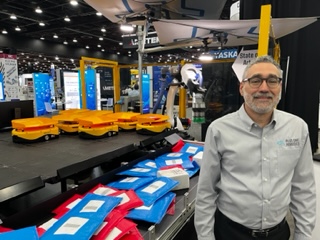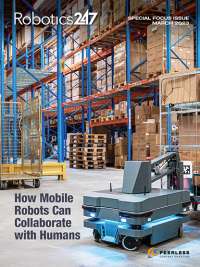The Association for Advancing Automation, or A3, had some encouraging growth news at the start of its Automate show in Detroit last week: After a record year in North America for industrial robot orders in 2021, that momentum carried into the first quarter of 2022.
A3’s figures showed that North American companies started the year by purchasing the most robots ever in a single quarter, with 11,595 robots sold at a value of $646 million. That’s up by 28% by units and 43% in dollars over the first quarter of 2021, and 7% and 25% respectively over the previous best quarter, Q4 of 2021. Back in February, A3 reported that industrial robot sales in North America had a record year in 2021, up 28% over 2020 and 14% higher than the previous top year of 2017.
A3’s figures are for industrial robots, which are mainly those with articulated arms that do tasks like picking and placing goods, as opposed to autonomous mobile robots (AMRs) that have gained a significant foothold in warehousing and materials handling.
Automate offered a varied mix of robotics companies
In my two days at Automate, that momentum was visible in the solid attendance at the event as well as the number and variety of exhibitors. By variety, I especially mean more AMR vendors with larger booths, compared with past Automate events.
Yes, the biggest exhibit spaces tended to be from major robotic arm providers such as FANUC, Universal Robots, KUKA, and others, but mobile robots were to be found at 20-plus booths, not just a handful. Then there were major, diversified technology providers such as ABB, Teradyne, or Zebra Technologies, which acquired AMR vendors and were showcasing mobile robots as part of their offerings.
This shift in exhibitor variety at the show is likely tied to companies facing underlying pressures in production and fulfillment operations. Everyone is dealing with acute labor challenges, tighter cycle-time pressures, and the need to move goods to end customers as quickly as possible once they can secure raw materials or receive finished goods to distribute. As a result, all types of automation are seeing strong interest. There are more robotic arm solutions being sold, but often as part of integrated solutions which aim to accelerate overall operational speed and efficiency.
Given these larger pressures, many of the vendors I visited were talking about integration of fixed piece-picking robots with AMRs, as well as integration of robots with other forms of automation such as conveyors and automated storage and retrieval systems (ASRSes). They also talked about integrating robots with the software and devices that support human-centered workflows.
Industry leaders I spoke with said this trend toward converged, integrated solutions is driven by industry needs around speeding up the entire flow of an operation, not just one corner of it.

Plus One touts partnership with Tompkins
At Plus One Robotics, which provides vision software for logistics robots, integration was the focus. Its booth demo showcased a robotic arm driven by Plus One’s vision software picking and placing a highly varied mix of parcels onto mobile robots from Tompkins Robotics. The two vendors announced a partnership earlier this year that allows Plus One’s perception software to work with Tompkins’ tSort AMRs to accelerate fulfillment processes in distribution centers (DCs).
Plus One’s software provides robots the hand-eye coordination to pick and place objects in DCs that have high package variability, said Erik Nieves, founder and CEO of Plus One Robotics. The tSort system offers scalable automated sortation.
Last fall, Plus One also partnered with Locus Robotics to integrate AI-enabled piece-picking with AMRs from Locus.
Generally, Nieves explained, automation of all types needs to become more integrated—not just robots with one another, but with traditional fixed automation like shuttles. Companies want to accelerate the overall fulfillment process while offsetting the inability to find enough human workers to stick with the manual tasks that often exist on the edges of their operations.
Nieves foresees that more and more companies will turn to solutions from robotics partners to extend the benefits of traditional automation like an ASRS. That way, they won’t have one big zone of automation in the middle of a DC with bottlenecks upstream or downstream, he said.
“If you make gains by automating in one area, but what exists is downstream remains manual, all you are really doing is moving the bottleneck,” said Nieves. “That is why fulfillment centers are going to turn to integrated solutions that can expand the benefits of automation out from the center, from something like an ASRS. That is where the value increasingly will come from—in deploying flexible robotics automation out from the middle, so you can have efficiencies not just in one area of your fulfillment center, but from one end of the building to the other.”
Zebra CEO says AMRs need to be interoperable
Another robotics industry executive I got to meet with was Melonee Wise, vice president of robotics automation at Zebra Technologies. Wise joined Zebra through the 2021 acquisition of Fetch Robotics, where she was the CEO. Fetch’s AMRs continue to advance with Zebra, with part of these advances coming in the form of integration with Zebra’s systems for work execution, mobile devices, scanning, data capture, and label printing.
We met Tuesday afternoon, shortly after Wise was part of a panel discussion at the event’s show floor theater, titled, “How Robotics and Automation Are Transforming the North American Economy,” which also featured other top industry leaders including executives from FANUC, Teradyne, and NVIDIA, as well as Greg Brown, vice president of the Advanced Technology Group at UPS.
During the panel, Wise observed that traditionally, robots have acted as “sole agents” focused on narrow tasks and are thus historically not adept at operating collaboratively in integrated, multi-agent settings. But that is changing via interoperability with other types of automation, as well as people-centered workflows and data capture devices and technologies like printers, she said.
After the panel, Wise said the value of mobile robots will increasingly come from how easily they integrate with other automation and with software and devices, so that user companies can speed the overall fulfillment process and have robots that work well in tandem with people.
“When you look at the needs of customers, what they are after is an end-to-end solution,” she said. “They don’t want just a robot; they want a solution to their problem.”
And if their problem is how do I get something off the shelf, and packed out, and onto a truck on time, it involves addressing this cascading series of tasks,” said Wise. “But if we can create this interconnected world that takes in mobile robots, and mobile devices, and things like printers, and packaging machines, then there is greater value for our customers, because they can optimize across their larger process.”
Also after that panel discussion, UPS’s Brown said that just in the past few years, advancements in artificial intellience and machine vision have made it possible to do more with industrial robots in logistics, because they now have the intelligence to be able to deal with more package variability.
“The technology is definitely maturing and getting better and more precise,” he said. “Depending on the application, it’s going to vary as to how useful it is today, but it’s definitely getting to the point where is it becoming more useful and allows us to think about ways to incorporate it into our operations and day-to-day practices.”
MiR customers install more AMRs than ever
AMR vendor executives said they are enjoying rapid growth, often driven by customers who started out with small proof-of-concept projects a few years ago, grew them into larger pilots, and have now expanded into production-scale fleets. Søren Nielsen, president of Mobile Industrial Robots (MiR), a subsidiary of Teradyne, said during a booth visit that this progression to larger fleets is fueling MiR’s growth.
“It is expanding rapidly both with new projects, and also, existing customers who now have much larger fleets,” Nielsen said. “The pattern we see is that they deployed maybe a few robots as a proof of concept, then expanded that further after 12 to 16 months, and now are increasing the size of their fleets to production scale. We now have customers with 100 to 200 robots in their fleets, and one customer with 86 robots in a single facility. And, at the same time, they are after better and better utilization of the robots.”
As robots are more widely deployed, Nielsen said that users want to achieve very high utilization of AMRs and want to eliminate incidents requiring manual intervention. Typically, it’s a matter of fine-tuning aspects like wireless network performance, the setup of docking points, or the analysis of traffic management patterns.
“AMRs are not toys anymore, they are becoming part of production environments, which is why we see this focus on utilization,” he said. “This is what we see—larger fleets and higher interest in utilization.”
MiR is known for larger-format AMRs, and while it is expanding its product line, there are many other types and potential use cases, said Nielsen. They include cleaning robots, inventory scanning robots, and assistive-pick AMRs.
It is inevitable customers will have AMRs from multiple vendors, with a resulting need for a layer of “interfleet management” software. Nielsen said that MIR isn’t developing this capability itself, adding that some of its customers are looking at using software from Amazon Web Services (AWS) called RoboRunner for this purpose.
Other Automate exhibits of interest
SVT Robotics had a sizeable booth at Automate. The vendor, which offers a software platform to speed and simplify integration of robotics solutions with host systems like a warehouse management system (WMS) or an enterprise resource planning (ERP) system, has drawn significant funding from investors that see industry interest in rapid integration of robotics solutions.
Jim Hodson, vice president of marketing for SVT, noted it’s not just deployment speed for one system that interests companies in SVT’s SOFTBOT platform and its “connector” approach to integration. It's also the ability over time to reconfigure a deployment or to integrate additional robots to a host system using the same connector, rather than starting from scratch.
Startup InOrbit was at the show exhibiting its cloud robot management platform, and also as one of the finalists for Automate’s Cowen Startup Challenge. Florian Pestoni, co-founder and CEO of InOrbit, explained that the company's software can help robot vendors and integrators improve the performance of what they offer to end users.
New “orchestration” features in the platform, along with a partner certification program, allow organizations to use the software to avoid conflicts between different types of AMRs without competing with the fleet software from each AMR vendor. For example, InOrbit’s solution can be used so that cleaning robots don’t interfere with large AMRs moving pallets, or to keep inventory counting bots out of the aisles being used by other robots.
“You want each system to do what it does best, without interfering with each other,” said Pestoni.
About the Author
Follow Robotics 24/7 on Linkedin
About the Author
Follow Robotics 24/7 on Linkedin
Article topics
Email Sign Up




















